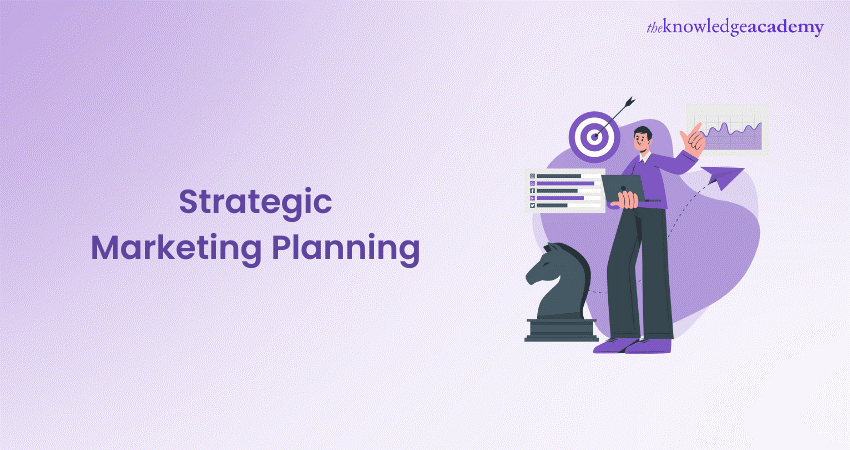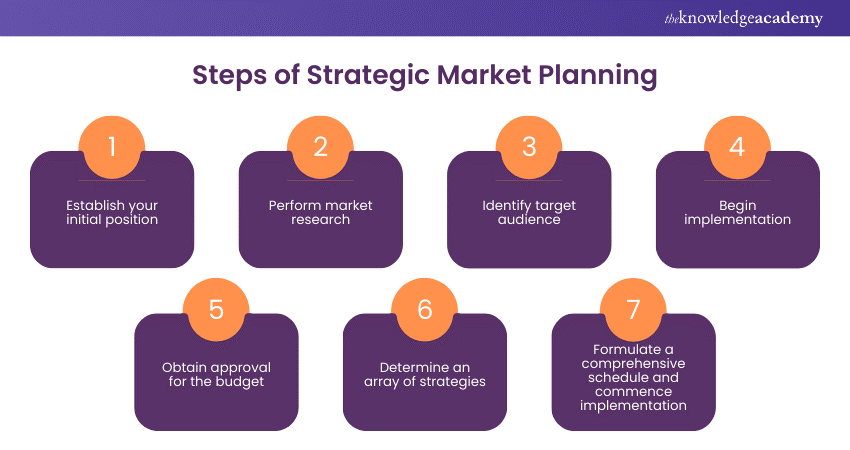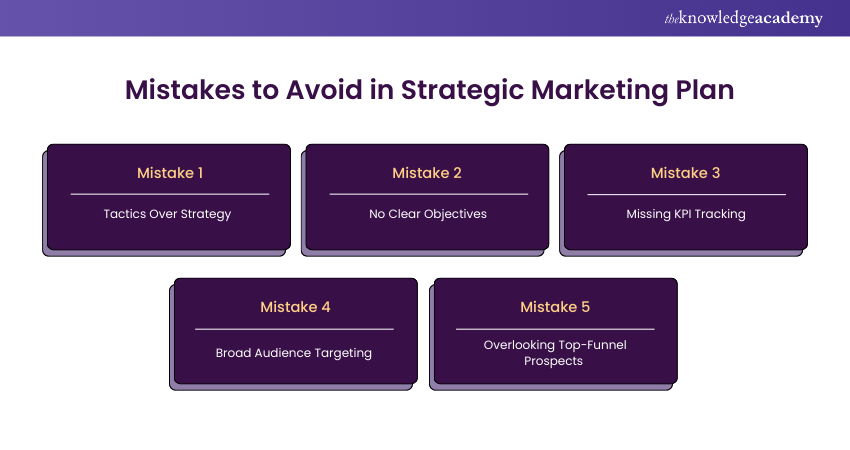We may not have the course you’re looking for. If you enquire or give us a call on 01344203999 and speak to our training experts, we may still be able to help with your training requirements.
We ensure quality, budget-alignment, and timely delivery by our expert instructors.

Do you feel like your marketing plan is not meeting your expectations? Many businesses struggle with this challenge frequently due to a lack of strategic guidance. Strategic Marketing Planning provides a roadmap that connects your marketing with your business objectives. Through the application of Strategic Marketing Planning, you can enhance the visibility of your brand, engage with your target audience, and attain long-lasting growth.
In this blog post, we will discuss the key advantages of Strategic Marketing Planning, investigate useful information, and offer helpful suggestions for keeping your business competitive in the market.
Table of Contents
1) What is Strategic Marketing Planning?
2) Benefits of Strategic Marketing Plan
3) Key Elements of Strategic Marketing Plan
4) Steps of Strategic Marketing Planning
5) Example of Strategic Marketing Planning
6) Common Mistakes to Avoid in Strategic Marketing Plan
7) Conclusion
What is Strategic Marketing Planning?
Strategic Marketing Planning is the process of developing a long-term plan to guide a company’s marketing efforts toward achieving its business objectives. It involves researching market trends, defining target audiences, setting measurable goals, and creating strategies that align with the company's overall mission and vision. Marketing Strategy Agencies play a crucial role in this process by helping businesses understand customer needs, competitive positioning, and industry dynamics. With their expertise, businesses can craft a comprehensive plan that effectively communicates value, attracts customers, and drives growth.
1) Understanding the Core Concept
Fundamentally, it is a roadmap that guides the marketing activities of an organisation; this, at its base, defines Strategic Marketing Planning. For small enterprises, incorporating small business marketing ideas into strategic plans ensures relevance and practicality. Forward-thinking marketing takes careful timing, analysis, and execution to coordinate other similar endeavours that help support the same goals. Strategic planning does not look at things tactically or in the shorter term; instead, it takes a wide-lens view. The internal and external variables affect an organisation's ability to find success within its given marketplace.
2) Holistic analysis
Strategic Marketing Planning begins with thoroughly examining the organisation's current standing in the market. This includes conducting a SWOT analysis—evaluating Strengths, Weaknesses, Opportunities, and Threats. By understanding internal capabilities and external market dynamics, businesses can identify areas for improvement and formulate strategies to leverage strengths while mitigating weaknesses and capitalising on emerging opportunities.
3) Aligning with Business Goals
One of the distinguishing features of strategic planning is its alignment with overall business objectives. It's not a standalone effort but an integral part of the broader Business Strategy. By ensuring that marketing goals resonate with the company's mission, vision, and long-term objectives, Strategic Marketing Planning helps create a unified approach, fostering synergy across different departments and functions.
Benefits of Strategic Marketing Plan
Dive in and unlock the potential of your business with a Strategic Marketing Plan to drive growth, aligns efforts, and maximises results.
a) Clear Direction: Ensures marketing efforts are in line with business objectives, ensuring that each action contributes to long-term goals.
b) Better Audience Understanding: Assists in customising messages that align with the requirements of your desired audience.
c) Efficient Resource Allocation: Efficient resource allocation entails concentrating on the most efficient channels and strategies to maximise return on investment (ROI).
d) Enhanced Competitive Advantage: Recognises distinctive value propositions, positioning your brand strategically within the market.
e) Market Adaptability: Market adaptability involves predicting trends and adjusting rapidly to outperform competitors.
f) Improved Decision-making: Offers a methodical way to assess fresh possibilities and obstacles.
g) Team Alignment: Guaranteeing effective communication to maintain everyone's attention on shared objectives.
h) Accountability and Tracking: Tracking progress and success becomes simpler by setting measurable objectives and timelines to ensure accountability.
i) Sustained Growth: Continuous development leads to constant progress and enduring achievements in the business world.
Key Elements of Strategic Marketing Plan
a) Market Research: A deep understanding of the market, including customer needs, preferences, and trends, as well as the competitive landscape, is essential for guiding decision-making.
b) Target Audience Identification: Clearly defining the customer segments to focus on helps tailor marketing efforts, ensuring that messaging resonates with the right people.
c) SWOT Analysis: A review of the company's internal strengths and weaknesses, along with external opportunities and threats, helps assess the current position and areas for growth.
d) Marketing Goals and Objectives: These should be Specific, Measurable, Achievable, Relevant, Time-bound (SMART) goals that align with the overall business objectives and provide direction for the plan.
e) Positioning and Differentiation: Developing a clear value proposition that sets the brand apart from competitors is key to capturing market share and attracting customers.
f) Marketing Mix (4Ps): The strategies around Product, Price, Place, and Promotion form the foundation of how the product or service will be marketed and delivered to customers.
g) Budget and Resource Allocation: managing marketing budget and assigning resources effectively ensures that the plan is realistic and actionable.
h) Monitoring and Evaluation: Establishing key performance indicators (KPIs) and regular monitoring ensures the effectiveness of the marketing strategies and allows for adjustments as needed.
These elements help create a cohesive strategy that drives growth and meets business objectives effectively.
Strategic Marketing Planning Steps
Effective Strategic Marketing Planning entails a systematic approach encompassing several key steps. Let's delve into each of these steps in detail:

1) Establish Your Initial Position
Before delving into Strategic Marketing Planning, assessing your current standing within the market is essential. This involves thoroughly analysing your company's Strengths, Weaknesses, Opportunities, and Threats (SWOT analysis). By clarifying your organisation's internal capabilities and external market dynamics, you can identify areas for improvement and devise strategies to capitalise on your strengths while mitigating potential risks.
2) Perform Market Research
Market research serves as the foundation of Strategic Marketing Planning, providing valuable insights into consumer preferences, competitor strategies, and industry trends. Businesses can gather relevant information through surveys, focus groups, and data analysis to inform their marketing decisions.
3) Identify a Specific Target Audience
While mass marketing strategies were once dominant, today's hypercompetitive landscape often necessitates a more targeted approach. Successful companies prioritise identifying and targeting specific market segments with tailored messaging and offerings. By defining a clear target audience based on demographics, psychographics, and behaviour patterns, businesses can personalise their marketing efforts. This can address their customers' unique needs and preferences, driving higher engagement and conversion rates.
4) Establish Clear and Measurable Objectives
Setting precise and measurable goals is essential for guiding Strategic Marketing Planning initiatives and assessing their effectiveness. Whether it's increasing brand awareness, driving sales growth, or expanding market share, objectives should be specific, achievable, and aligned with overall business goals. By implementing Key Performance Indicators (KPIs) and metrics to track progress, organisations can measure the success of their marketing implementations.
5) Obtain Approval for the Budget
Allocating sufficient resources is crucial for executing Strategic Marketing plans effectively. Once objectives are defined, organisations must obtain approval for the budget required to implement various marketing initiatives. This may include allocating funds for advertising campaigns, digital marketing, market research, and other promotional activities.
6) Determine an Array of Strategies
With objectives set and resources allocated, the next step is to develop a comprehensive set of marketing strategies to achieve desired outcomes. This may involve a mix of tactics, such as content marketing, social media engagement, influencer partnerships, email campaigns, and SEO optimisation tailored to reach and engage target audiences across various channels.
7) Formulate a Comprehensive Schedule and Commence Implementation
Once strategies are finalised, it's time to develop a detailed schedule outlining the timeline and sequence of marketing activities. This includes setting deadlines, assigning responsibilities, and coordinating efforts across different departments or teams involved in execution. By adhering to a structured timeline and closely monitoring progress, businesses can ensure that marketing initiatives are implemented efficiently and effectively, maximising their impact and driving desired outcomes.
Boost your business growth with our expert-led Business Marketing Strategies – Join today!
Common Mistakes to Avoid in Strategic Marketing Plan
Creating a marketing strategy is not a precise science, but typical errors can impede achievement. Here are five crucial mistakes and how to prevent them.

1) Mistake 1: Tactics Over Strategy
Business owners and marketing executives frequently focus on tactics instead of having a well-defined strategy. For instance, they could mention the need for a new website but find it difficult to articulate the reasons behind it. They feel that their existing website is not working well, but they struggle to connect it to larger marketing objectives.
Rather than focusing solely on tactics such as websites, SEO, or social media, concentrate on creating a strategic plan that aligns with your objectives. Next, select strategies that are in accordance with reaching those objectives.
2) Mistake 2: No Clear Objectives
Often, clear goals and objectives are neglected when there is no strategy in place. Is your website being updated for branding purposes or to improve customer satisfaction? Defining goals like enhancing brand recognition, generating more leads, driving e-commerce sales, or drawing in-store customers is crucial.
3) Mistake 3: Missing KPI Tracking
If objectives are not clear, KPIs are frequently not established or monitored. This mistake makes it difficult to gauge success. KPIs need to align with your objectives, such as monitoring website traffic for brand recognition or tracking sales for purchase-oriented objectives.
4) Mistake 4: Broad Audience Targeting
Identifying your target audience is a good beginning, but creating customer personas offers more detailed insights. Crafting a strategy and message that resonates with specific personas is simpler. For example, targeting a specific individual like "Molly," a 36-year-old health-conscious mother with a Master's degree who purchases organic products, is more effective than targeting a broader group like "moms with college degrees."
5) Mistake 5: Overlooking Top-Funnel Prospects
Most competitors concentrate on prospects at the bottom of the sales funnel who are already prepared to make a purchase. Only a small number of people are targeting potential customers at the beginning of the buying process, resulting in missed chances to attract their attention early on. Offering useful insights to potential customers at the beginning of their journey can familiarise them with your brand and create trust. One example would be homebuilders focusing on first-time buyers, creating information to address inquiries such as, "How can I go about applying for a mortgage?"
Example of Strategic Marketing Planning
1) Market Research
GreenTech conducts in-depth research, revealing a rising demand for sustainable home products. Their primary audience comprises environmentally conscious millennials and young families who value eco-friendly solutions. The market is competitive, with established brands and niche startups vying for attention.
2) Target Audience Identification
GreenTech identifies two key customer segments:
Young urban families looking for affordable, sustainable home solutions.
Eco-conscious millennials willing to invest in high-quality, eco-friendly products.
3) SWOT Analysis
a) Strengths: Innovative eco-friendly products and strong sustainability credentials.
b) Weaknesses: Low brand recognition and higher production costs.
c) Opportunities: Growing demand for sustainable products and potential influencer partnerships.
d) Threats: Fierce competition from larger, well-funded brands.
4) Marketing Goals and Objectives
GreenTech sets specific, measurable goals:
Increase website traffic by 30% within six months.
Achieve a 20% sales increase over the next year.
Grow social media following by 10,000 within six months through targeted campaigns.
5) Positioning and Differentiation
GreenTech positions itself as a premium brand, offering stylish, eco-friendly home products. Their USP lies in their use of 100% biodegradable materials and packaging, setting them apart from competitors.
6) Marketing Mix (4Ps)
a) Product: A range of sustainable home products, including reusable kitchen wraps, compostable trash bags, and bamboo décor.
b) Price: A mid-to-high pricing strategy to reflect the quality and sustainability of the products.
c) Place: Primarily sold through their e-commerce platform, with potential expansion into eco-conscious retail stores.
d) Promotion: A digital-first approach, focusing on social media marketing, influencer partnerships, email campaigns, and SEO.
7) Budget and Resource Allocation
A £50,000 marketing budget is allocated towards paid social media ads, SEO optimisation, influencer collaborations, and content creation.
8) Monitoring and Evaluation
Key performance indicators (KPIs) such as website traffic, conversion rates, social media engagement, and sales data will be tracked using Google Analytics and social media insights, allowing for ongoing adjustments to improve performance.
Unlock the skills of marketing with our MarTech Training – Join today!
Conclusion
Strategic Marketing Planning is critical for an organisation to address the ambiguity and secure its path of success towards growing in a competitive business. A business can systematically see the wider market opportunity by targeting specific audience segments and then align resources to design and execute impactful Marketing Campaigns that resonate with consumers and generate measurable results. Embedding Strategic Marketing Planning deeply into your business will set you up for success over the long term as markets change and evolve
Be at the forefront of Marketing with our Strategic Marketing Masterclass – Join today!
Frequently Asked Questions
What Should be Included in a Strategic Marketing Plan?

A Strategic Marketing Plan must consist of a mission statement, situational analysis, target audience, marketing objectives, competitive analysis, strategies, budget, performance metrics, and an execution timeline.
What are the Seven Strategies of a Marketing Plan?

The seven tactics consist of product, price, promotion, place, people, process, and physical evidence. These factors, referred to as the marketing mix, direct you on how to efficiently connect and involve your desired audience.
What are the Other Resources and Offers Provided by The Knowledge Academy?

The Knowledge Academy takes global learning to new heights, offering over 3,000 online courses across 490+ locations in 190+ countries. This expansive reach ensures accessibility and convenience for learners worldwide.
Alongside our diverse Online Course Catalogue, encompassing 19 major categories, we go the extra mile by providing a plethora of free educational Online Resources like News updates, Blogs, videos, webinars, and interview questions. Tailoring learning experiences further, professionals can maximise value with customisable Course Bundles of TKA.
What is The Knowledge Pass, and How Does it Work?

The Knowledge Academy’s Knowledge Pass, a prepaid voucher, adds another layer of flexibility, allowing course bookings over a 12-month period. Join us on a journey where education knows no bounds.
What are the Related Courses and Blogs Provided by The Knowledge Academy?

The Knowledge Academy offers various Marketing Courses including Content Marketing Course, Web Analytics Course, etc. These courses cater to different skill levels, providing comprehensive insights into What is a Marketing Campaign.
Our Digital Marketing Blogs cover a range of topics related to Digital marketing, offering valuable resources, best practices, and industry insights. Whether you are a beginner or looking to advance your Marketing skills, The Knowledge Academy's diverse courses and informative blogs have you covered.
Upcoming Digital Marketing Resources Batches & Dates
Date
 Strategic Marketing Course
Strategic Marketing Course
Fri 25th Apr 2025
Fri 20th Jun 2025
Fri 22nd Aug 2025
Fri 17th Oct 2025
Fri 19th Dec 2025






 Top Rated Course
Top Rated Course



 If you wish to make any changes to your course, please
If you wish to make any changes to your course, please


